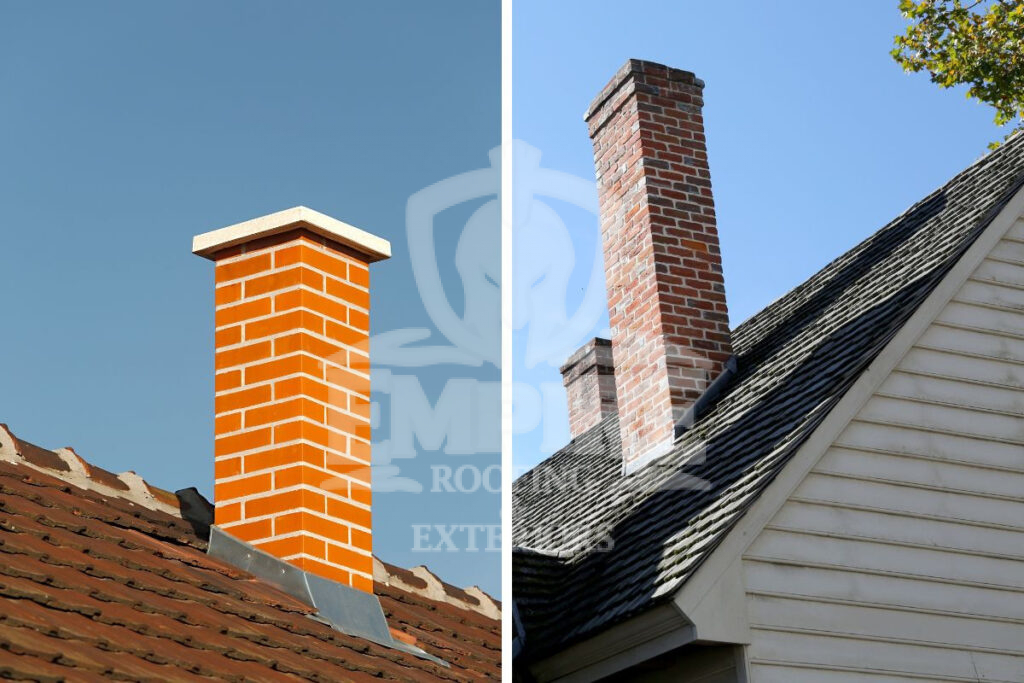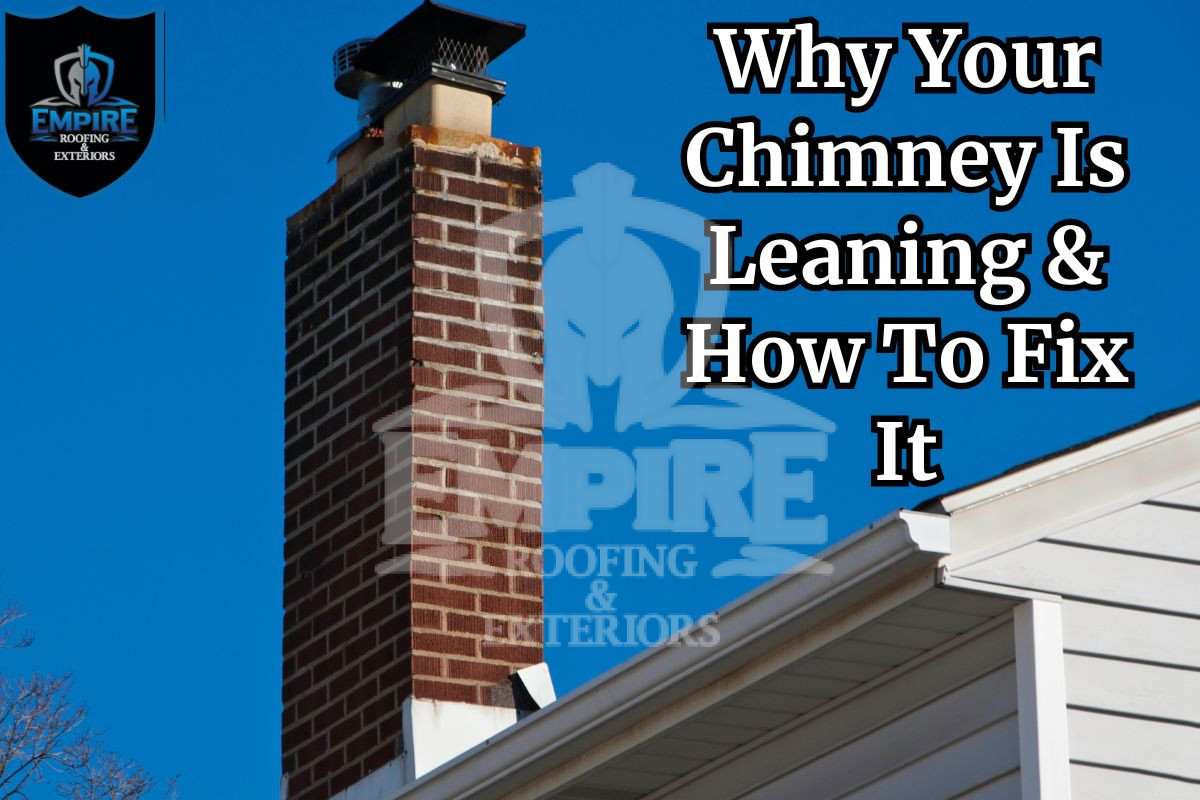At some point, many homeowners have to deal with the major problem of a leaning chimney. At first look, a leaning chimney might not seem like a major deal, but often there are safety and structural risks involved. We’ll look at the causes of leaning chimneys, the damgers they pose, and how to repair for them in this blog post, along with a general pricing breakdown for the work.
What is a Leaning Chimney?
When a chimney starts to deviate from its vertical position, it can be both visually unsettling and structurally problematic. Over time, various factors can impact its stability, causing it to lean. A properly installed chimney should remain upright, so any noticeable tilt is a sign of underlying issues that need immediate attention.
Why Do Chimneys Lean?
Several common causes can contribute to a chimney leaning:

#1. Foundation Problems
The foundation of a home is crucial for a chimney’s stability. Over time, the soil beneath it can shift, erode, or become waterlogged, leading to tilting. This is especially common in areas with clay-rich soils or frequent earthquakes. If the foundation is shallow or poorly built, it won’t provide adequate support.
#2. Water Damage
Water is a significant threat to chimneys. Continuous exposure to rain, snow, and ice can erode the mortar, allowing moisture to seep in. Freezing and thawing cycles can worsen this, gradually pushing the chimney out of alignment. If the mortar cracks or the bricks break down, it compromises the chimney’s strength.
#3. Poor Construction
Many chimneys lean due to poor construction. Using low-quality materials or not adhering to building codes can result in inadequate support. Weak mortar joints or misaligned bricks can lead to structural problems, increasing the risk of leaning over time.
#4. Soil Conditions
Soil stability is vital for chimney support. Certain types of clay soils can swell when wet and shrink when dry, causing movement. Loose or sandy soils may also struggle to support heavy structures like homes with large chimneys, leading to tilting. Soil erosion or poor drainage can further exacerbate these issues.
#5. Normal House Settling
All homes settle over time. While minor settling is usually normal, excessive settling can cause structural issues, including a leaning chimney. It’s important to monitor for signs of settling that could impact the chimney’s alignment.
#6. Lack of Proper Maintenance
Regular maintenance is essential for chimney stability. If left unaddressed, issues like cracked mortar or missing bricks can lead to more serious problems, including leaning. Regular inspections can help catch these issues early.
#7. Vibrations from Traffic
If your home is near heavy traffic or a construction site, constant vibrations can affect the chimney’s stability. Over time, these vibrations can loosen the mortar and contribute to the chimney leaning.
#8. Age and Wear
Even well-built chimneys can lean with age. Years of exposure to the elements, temperature changes, and general wear can cause a slow shift over time.
Signs Your Chimney Is Leaning
As a homeowner, it is important to keep an eye out for some common signs of a leaning chimney, like:
Gaps Between the Chimney and House
If you spot gaps or cracks where the chimney meets the house, it’s a clear sign the chimney has shifted. These gaps not only weaken the structure but also allow moisture to seep in, leading to further damage and possibly mold growth.
Loose Flashing
Flashing, which seals the chimney to the roof, can become loose or misaligned if the chimney is leaning. This can result in water leaks, causing additional damage and increasing repair costs if not addressed.
Tilting Bricks
Uneven or shifted bricks are a strong indicator that the chimney’s structure is compromised. This can happen due to moisture damage or poor construction, and it’s crucial to fix it promptly to prevent bigger problems down the road.
Off-Center Chimney
If the chimney appears off-center or misaligned in the attic, it could mean the house is settling unevenly. This is a warning sign of possible foundation issues that require immediate attention.
Why Is A Leaning Chimney Dangerous?
Now that you know the signs of damage, next, we’ll discuss why it’s crucial to address your leaning chimney as soon as possible.
1. Collapse Risk
A leaning chimney is at risk of collapsing. As it tilts, it becomes weaker, and if it falls, it can cause serious roof damage and injuries.
2. Water Damage
Gaps formed by a leaning chimney can let water in, leading to damage inside the home. This moisture can cause mold, rotting wood, and higher repair costs over time.
3. Flue Liner Compromise
The flue liner vents smoke and gases from the fireplace. If the chimney leans, it can crack the liner, risking chimney fires and carbon monoxide leaks, which endanger your home’s safety.
4. Roof Damage
A leaning chimney can harm the roof, especially around shingles and gutters. Misalignment can lead to leaks and costly structural repairs.
5. Pest Infestation
Gaps from a leaning chimney can allow pests like rodents and insects into the attic. This can create health issues and increase maintenance costs as you deal with infestations.
6. Increased Repair Costs
Ignoring a leaning chimney will likely lead to more damage and higher repair costs over time. Quick action is essential to manage risks and expenses effectively.
Cost Considerations
The cost to fix a leaning chimney can vary widely based on several factors, including the damage’s severity, the materials used, and the type of repairs needed. Here are the key points to consider:
Cost Range for Leaning Chimney Repairs
- Average Repair Costs: Generally, repairing a leaning chimney costs between $1,250 and $4,000. This range reflects different conditions and complexities of the repairs.
- High-End Costs: For severe leaning or major structural issues, costs can rise to $7,000 or more, especially if a complete rebuild is required.
Factors Influencing Repair Costs
A. Extent of Damage:
Minor repairs may cost around $200 to $800, while significant structural damage can range from $2,500 to $8,000.
If the leaning is caused by foundation issues, expect additional costs for those repairs.
B. Material Type:
The chimney’s material (like brick or stucco) affects the costs. For instance:
- Brick chimney repairs usually range from $175 to $1,000, with extensive damage costing more.
- Stucco repairs can be pricier, averaging between $500 and $2,000.
Also Read: Do You Need A Chimney Cap?
How to Fix a Leaning Chimney
While there are many ways to fix a leaning chimney, here is a general overview of the process:
Professional Inspection
If you notice your chimney leaning, seek professional help right away. Certified inspectors can evaluate the damage and recommend tailored solutions for your situation.
Repair Options
1. Address Foundation Issues
If the house foundation is the issue, hire an expert to stabilize it.
2. Strapping
For minor tilting, strapping can be effective. This method secures the chimney with metal straps anchored to the roof or surrounding masonry, helping stabilize it and prevent further movement.
3. Helical Piers
If there are significant foundation issues, installing helical piers may be necessary. These steel piers are driven deep into stable soil under the chimney’s foundation, providing extra support and stopping further settling or tilting.
4. Rebuilding
If the damage is severe, complete reconstruction of the chimney might be needed. This involves dismantling the existing structure and rebuilding it to meet modern building standards for long-lasting stability.
5. Fix Structural Problems
Check the chimney for cracks and damaged bricks. You may need to replace old mortar or bricks and repair the flashing to prevent water damage.
6. Add Braces
Consider adding steel braces around the chimney for extra support against wind or earthquakes. Proper installation is key for effectiveness.
7. Install a Support System
If needed, a chimney support system with heavy-duty brackets can help distribute weight and stabilize the chimney. Consult a structural engineer for advice.
Get Your Leaning Chimney Fixed With Empire Roofing & Exteriors
It’s important to take a leaning chimney seriously. Acting quickly can prevent safety risks and expensive repairs, whether the issue comes from poor construction, water damage, or foundation problems. By knowing the signs and causes of a leaning chimney, you can take steps to fix it and protect your home. Taking action now helps keep your property safe and ensures your family’s well-being.
Don’t let a leaning chimney jeopardize the safety and beauty of your home. At Empire Roofing & Exteriors, we specialize in quality chimney repair services, offering expert inspections and reliable solutions to restore your chimney’s integrity. Whether you need minor repairs or a complete rebuild, our experienced team is here to ensure your chimney stands tall for years to come. Contact us today at (225) 347-8877 for a consultation!
